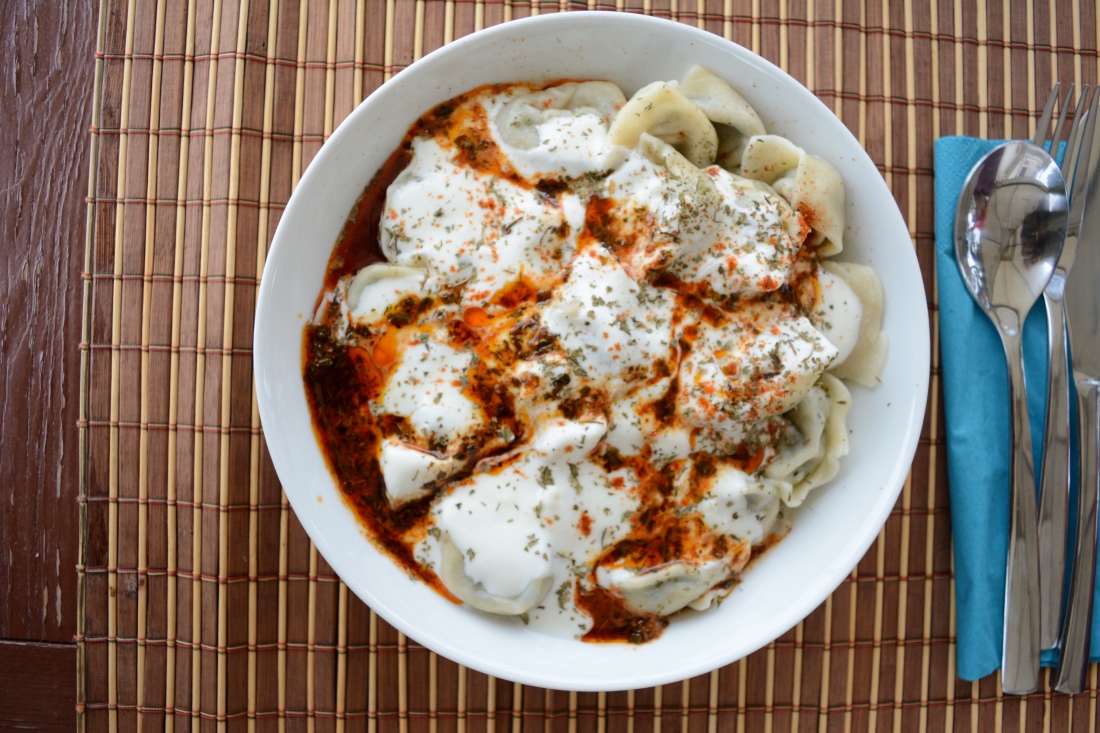From the Chinese soup dumpling to the Italian ravioli, any culture worth its salt has a dumpling dish of sorts. In Turkey, we have mantı.*
Mantı is made from a simple dough, rolled into a thin sheet. The sheet is cut into small(ish) squares and, traditionally, a small amount of a ground lamb mixture is placed in the middle of each square. From here, the dough could be folded and wrapped, sealed (or not), in a number of ways. While they could be steamed, fried or baked, like so many other Asian dumplings, these ones are boiled usually in a some sort of stock. Once boiled, they are scooped up with a slotted spoon, placed into a shallow serving bowl, and topped with garlic yogurt. Seeing that Turks were probably one of the first to develop yogurt in all its wonder, it seems appropriate that the dairy staple is incorporated into the Turkish mantı. Every spoonful is filled with a couple of dumplings some yogurt and that red (sometimes spicy) buttery sauce. The yogurt tempers the piping hot, tiny dumplings and that mystery red sauce (of which recipe no one will ever give away).
Every household family has their way of making mantı. And while you can buy prepared or even frozen mantı, its always considered proper form to make it from scratch. In fact, there are still some that joke or poke at stories where a woman’s mantı-making skills are the quality barometer of her wifedom. It was said that the prospective bride should cook the dish for her, equally prospective, mother-in-law. The smaller the dumpling the more skilled the woman, so much so that forty (that’s 40) dumplings should be able to cuddle comfortably on one spoon – let’s hope those brides had large spoons.
There are some regions that totally by pass the dumpling aspect altogether and celebrate the core of mantı: starch, dairy and hot oil. In an effort to waste not, central Anatolians started replacing the dumplings with stale, old bread. It’s still delicious.

When you are not trying to impress a mother-in-law that is not yours yet, there are a couple of other ways to prepare and make the dish. There are several shops that specialize specifically in yufka and mantı. They prepare the mantı dumplings on the spot and sell them as is or they let them dry and then sell them. Either way, this is a perfectly good option – no matter what any mother-in-law says. Once you’ve bought them, run home. You’ll want to run because you will be that much closer to dumpling bliss. Boil ‘em, strain ‘em, top them with a dollop of the fullest and fattiest yogurt you got. Bring a bit of oil, butter, Aleppo pepper flakes and ground sweet pepper to boil. Remove from heat. Drizzle as little or as much as you want over the yogurt. Top the whole thing with either dried mint and sumac. If you are like us and are completely indifferent to the olfactory systems of those around you, then you’ll want to add garlic to the yogurt – a lot of it.
For those who are not into the whole boiling thing, you too have options.
Bodrum mantı
Bodrum mantı along the European coast of the Bosphorus is one of the more popular spots to chow down on a plate. This place is especially nice because it is open late – very late. And they don’t judge.
Sinop Mantısı
It’s just done right. Not to mention they have several options such as a walnut-incorporated mantı.
Aşkana Mantı
Serving mantı since 1987. This place only has two things on their menu: mantı and çiğ börek. Heaven? Yep.
Sayla Mantı
For those of us who prefer the eastern side of the city, Sayla Mantı is said to be the best.
We’ve found that eating mantı outside on a cold, rainy, gray day might just be the best way to consume it.
**A debatable sentence. The brilliant concept of wrapping a semi-cooked filling in dough has traveled far and wide. Some would say that dumplings world-wide possible have a single origin. For instance, Korean cuisine features mandou, a dumpling dish and phonetically similar. For an excellent talk on the subject of the traveling dumpling, watch Aylin Öney Tan at The Turkish Cultural Foundation.




These look and sound delicious. Yum!!
LikeLiked by 1 person